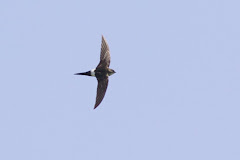We travelled by train to Ystad in Sweden and then caught the catamaran from Ystad to Rønne, the major town on the island. From there we caught a bus to Allinge in the north, our base for the three days.
The weather started off cold and windy but, fortunately, it just got better and better and by sunday evening when we were making our way home, we enjoyed a flat calm sea crossing and a stunning sunset. Most of our time was spent walking the coastal path around the north or cycling - on the last day we pedalled our way to Gudhjem on the east coast.
Birdwise, Bornholm is noted for its breeding Tengmalm's Owls. I didn't try to see any (they are very elusive this time of year) but during the weekend I did see Wood Warbler, Hobby (my first of the year), Goosander, hundreds of Red-breasted Merganser, several Yellow-legged Gulls, a late Waxwing and a probable RIVER WARBLER that sang briefly in a wet gully (and unfortunately didn't show itself in a brief search). However, the highlight had to be the two Nutcrackers that flew over our heads heading north along the coast. Almost certainly part of the autumn 2008 invasion moving back north for the summer. A great sight! Flowers were in full bloom (if only I knew what any of them were!) and a Slow Worm was a surprise basking in the short grass on the coastal path.
Just to the north-east of Bornholm lies an even smaller island - Christiansø - that is famous in Danish birding circles. Being the most easterly point of Denmark and an island in the Baltic means that it has claimed many firsts for Denmark and many mega rarities, particularly in Autumn. Highlights include species such as Siberian Rubythroat, Egyptian Nightjar, Blue-cheeked Bee-eater, Lanceolated Warbler, White's Thrush, Siberian Accentor etc etc
As expected the accommodation, food and locals were all wonderful and I can't wait to go back, maybe for a sneaky visit in September....!
Photos: the north of Bornholm; Libby in Gudhjem; some yellow irises (anyone know what they are?); and the famous (at least in Danish birding circles) quay for the ferry to Christiansø.










No comments:
Post a Comment